Screening and Assessment for Family Engagement, Retention, and ...
Screening and Assessment for Family Engagement, Retention, and ...
Screening and Assessment for Family Engagement, Retention, and ...
Create successful ePaper yourself
Turn your PDF publications into a flip-book with our unique Google optimized e-Paper software.
SECTION III: COLLABORATIVE PRACTICE AT THE FRONTLINE<br />
Section I of this guidebook makes the case <strong>for</strong> collaboration <strong>and</strong> presents a framework <strong>for</strong> establishing<br />
a governance structure including an Oversight Committee, Steering Committee, <strong>and</strong> Subcommittees<br />
charged with creating policies <strong>and</strong> protocols that allow staff <strong>and</strong> systems to work together. Section<br />
II outlines some of the individual <strong>and</strong> shared responsibilities of the child welfare, alcohol <strong>and</strong> drug<br />
service, <strong>and</strong> court systems in creating <strong>and</strong> sustaining effective relationships. This section focuses on<br />
frontline practices, providing in<strong>for</strong>mation to help staff implement policies <strong>and</strong> procedures that have<br />
been developed <strong>and</strong> approved by subcommittees <strong>and</strong> the Steering Committee. It is preferable that child<br />
welfare, alcohol <strong>and</strong> drug services, <strong>and</strong> court staff in local offices participate on Subcommittees <strong>and</strong><br />
there<strong>for</strong>e identify <strong>and</strong> recommend the screening <strong>and</strong> assessment protocols they will use in their offices.<br />
The Steering Committee <strong>and</strong> relevant Subcommittees should guide, oversee, <strong>and</strong> evaluate the activities<br />
described below <strong>and</strong> should use local experiences to revise State policies <strong>and</strong> procedures where required.<br />
The terms “screening” <strong>and</strong> “assessment” are widely used by staff from child welfare, alcohol <strong>and</strong> drug,<br />
<strong>and</strong> court systems. They are sometimes used interchangeably, <strong>and</strong> they often mean different things to<br />
different systems. For example, when calls come in to the child welfare hotline, the worker asks a series<br />
of brief screening questions to determine whether a report of abuse or neglect will be accepted <strong>for</strong> an inperson<br />
response, <strong>and</strong> if accepted, whether the situation requires an immediate visit to the home. When<br />
reports are accepted <strong>and</strong> workers visit the home, they quickly assess the home situation to determine<br />
whether children are safe or whether they are at imminent risk <strong>and</strong> must be removed, at least until<br />
further assessments have been completed. After an initial determination has been made that children are<br />
not safe at home or are at serious enough risk to warrant further involvement with child welfare, workers<br />
resolve the immediate safety concern <strong>and</strong> then begin a more comprehensive process of screening <strong>and</strong><br />
assessment <strong>for</strong> a range of services. At this point, screening <strong>and</strong> assessments <strong>for</strong> substance use disorders<br />
should take place.<br />
<strong>Screening</strong> <strong>and</strong> assessment are not specific events conducted by professional staff at predetermined<br />
points in a family’s involvement with child welfare, alcohol <strong>and</strong> drug treatment, <strong>and</strong> court systems.<br />
Rather, they are continual processes that engage both families <strong>and</strong> staff in identifying family strengths,<br />
developing services, <strong>and</strong> monitoring progress <strong>and</strong> addressing challenges. These processes are more<br />
helpful to families <strong>and</strong> more efficient <strong>for</strong> staff if they are undertaken in a coordinated rather than parallel<br />
manner. The Introduction to this guidebook lays out questions that all three systems struggle to address,<br />
<strong>and</strong> proposes that these questions are better answered if systems coordinate their responses than if they<br />
respond in isolation.<br />
These questions are repeated here:<br />
•<br />
•<br />
•<br />
•<br />
Is there a substance use or child abuse <strong>and</strong> neglect issue in the family, <strong>and</strong> if so, what is the<br />
immediacy of the issue?<br />
What are the nature <strong>and</strong> extent of the substance use or child abuse <strong>and</strong> neglect issue?<br />
What is the response to the substance use or child abuse <strong>and</strong> neglect issue? Are there demonstrable<br />
changes? Is the family ready <strong>for</strong> transition, <strong>and</strong> what happens after discharge?<br />
Did the interventions work?<br />
Some local agencies may want to improve their ability to screen <strong>and</strong> assess families but are not prepared<br />
to address broader issues regarding collaborative approaches to screening <strong>and</strong> assessment. The<br />
in<strong>for</strong>mation included in this section provides practical guidance regarding screening <strong>and</strong> assessment<br />
39


